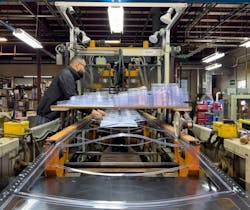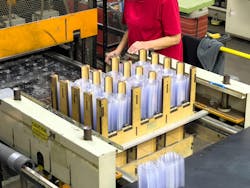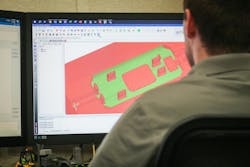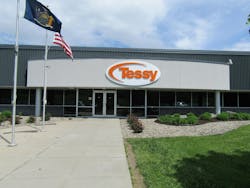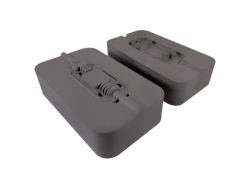Primary machines, accessories demand processors' attention at NPE
By Karen Hanna
Technology might be NPE’s biggest draw, but for processors looking ahead to the show, it’s so much more than a shopping excursion.
The opportunities to win new business, compare notes with peers, check out new equipment and even raise a glass among robots and friends had processors before the show eager for a trip that three years ago was derailed by the COVID-19 pandemic.
“Because of the six-year gap, there seems to be quite a bit of excitement around this year's NPE,” said Sean Cooper, sales manager for Tessy Plastics Corp., a custom molder based in Skaneateles, N.Y. “We're hoping we get a lot of representation from both the customer base that we already have, as well as that we want to work with, that don't currently have any business in our portfolio.”
Three years since it was canceled, and six years since it was last held, NPE — expected to attract 55,000 visitors — had processors abuzz with anticipation. On LinkedIn, attendees’ posts featured party popper emojis to boost the event.
For some processors, like Cooper, NPE is a marketing mecca, for others, a technology showcase.
Jay Baker is the CEO of Jamestown Plastics, which he describes as “sort of a ‘what the hell, let’s give it a go’ company” that’s committed to surmounting manufacturing challenges others might decline. Technology and innovation give the 200-plus-employee Brocton, N.Y.-based thermoforming manufacturer its competitive edge.
“A lot happens in six years,” he said. “I mean, it’s mind-boggling. We are always adding to our equipment roster, staying at the forefront of technology and frequently pushing the envelope with custom build and custom applications.”
Ready to be wowed
For an industry that for a time made do with Zoom calls and virtual visits, NPE offered the promise of a coming-out celebration. Hannah Belmont, the talent development manager at Westminster Tool Inc., viewed it as another sign manufacturers are emerging from the shellshock of unprecedented disruptions.
She and other processors had their wish lists ready.
“I feel like COVID has also kind of taught us to better look toward the future,” she said. “I feel like in the last three to five years, specifically, everybody's really had their head down, and they’re like, ‘I just need to get through the year.’ ‘Sustain, sustain, sustain, survive,’ that is what I got so used to hearing. And I feel like this year — maybe it’s with NPE coming? — people are more optimistic about investing in the future. ... It’s more like, ‘OK, let’s think strategically about what we’re going to invest in in the next five years.’ ”
NPE 2024 meets Industry 4.0
Underlying the vast array of technologies at the show were promises by OEMs of advances in better connecting machines and leveraging data to improve processes.
Baker said he’s excited about the evolution of Industry 4.0 — a major emphasis for NPE.
“The 4.0 stuff is absolutely fascinating, there’s no doubt about it. Incredibly powerful,” he said. “But I think any innovative company that’s tried to stay ahead of the competition has been doing much of that, maybe not quite as data-driven, computer-model world as people think of 4.0, but certainly the roots, the underpinnings, that’s how you survive and thrive.”
Machine-utilization tracking is one strategy paying dividends for Westminster Tool. The company also hoped to explore machine monitoring at the show.
Belmont called utilization-tracking technologies — in place at Westminster Tool for the last three to five years — a “game changer.”
“I think we’re getting a lot better at tracking the utilization not just for machines, but using it to make decisions about building molds more efficiently. We do have spindle-utilization software, but is that something that we could integrate into our Sumitomo molding machines? ... Overall equipment efficiency, these are the kind of KPIs that ... we’re shifting to a little bit more of a data-driven mindset ... that we weren’t as focused on during the last NPE.”
However, taking advantage of all that data still can be a challenge.
Innovations that provide insights into data aren’t always accessible, Belmont observed.
ERP systems, for example, represent a hefty investment for companies like Westminster Tool, which, with just about 35 employees, has yet to find a balance between needed capabilities and cost.
“There’s not a lot of middle ground in ERP systems,” Belmont said. “... It can only do one or two things, or it’s so expensive and so in-depth, with so many features that we don’t need, that we can’t just justify it from a business cost.”
Baker looks forward to seeing how artificial intelligence might help companies sort and make sense of all their data.
“You’ve got tons and tons of data that you don’t do anything with but is being collected, and system integration where you’re picking up that data and artificial intelligence or whatever is looking at it and going, ‘Hey, did you know your machine in Texas, which is running this, could be doing it this much faster because you got a machine in Taiwan that’s this much faster?’ ... That’s pretty remarkable,” he said.
Though an inventor himself, Baker admitted he isn’t a technology guy.
“I hope I keep hiring smart people to understand this [stuff] because I don’t,” he quipped.
Smorgasbord of equipment
The 1’s and 0’s of Industry 4.0 weren’t processors’ only focus. For them, the chance to see actual equipment making parts was a big draw.
“I feel like people are even more hungry than they’ve ever been to see some of the mechanics in person,” Belmont said.
On the agenda for processors: everything from primary machines to upgrades of jury-rigged vision systems originally MacGyvered on the plant floor.
For Jamestown Plastics, NPE represented an opportunity to learn more about suppliers of the primary equipment it relies on to make its parts. It’s traditionally acquired thermoformers from SencorpWhite, but that company announced in July it would no longer make the machines.
At its three plants, it also runs Maac Machinery thermoformers — a “fantastic product,” Baker said.
“It’ll be nice to see all the players in one spot at the same time,” he said. “So, you can kind of kick the tires on a few different models and decide who you want to be playing with going forward in the future.”
Tessy Plastics’ shopping ambitions were more modest. Ben Passetti, Tessy Plastics R&D engineer, noted that breakthrough technologies often debut at the K show or Fakuma before landing in the U.S. So, the 14 members of the traveling team representing the 1,600-employee company weren’t going to the show anticipating they’d see trailblazing technologies.
“We’re certainly looking at emerging technologies,” Passetti said. “But we’re also looking to strengthen what I would call our core competencies, which is our day-to-day practices of injection molding, and how can we support our business and improve efficiencies in avenues of non-Industry 4.0 activities? We look heavily in that area, simply because it helps support our overlying business practices of efficiency and quality. Machine manufacturers and suppliers are always pushing the envelope there. We’re just looking at what they’re pushing, whether it fits our business case.”
Meanwhile, Baker was headed to the show ready to be impressed.
“There’s probably going to be a lot of companies trying to make a big statement with their newest and best and greatest because they haven’t had the real opportunity to do so,” he said.
While 3D printing companies didn’t figure to take leading roles at NPE, the technologies have captured Baker’s fancy. With them, Baker said Jamestown Plastics could optimize some applications — including the CNC machining of parts and the design and production of tooling. Some of the possibilities for 3D metal printing, in particular, are “mind-blowing.”
Baker said he expects one technology won’t supplant the other; rather, companies like his will find a way to best exploit the advantages of both 3D printers and more conventional manufacturing approaches.
“What you get at the end of the process, how does one approach versus the other approach either give you more flexibility in design, or a better surface finish ... and at what cost? So, it’s going to be very fascinating watching, because they’re both advancing at a very rapid pace. And we like to be at the forefront of that stuff.”
“It opens up an incredible Pandora’s box but in a good way,” he said.
For Belmont, who six years ago worked in a far different role — as an editor of a trade publication, interested in all the technologies at NPE — the show presented an opportunity to delve into some machinery accessories. Specifically, she said, Westminster Tool was interested in mold flow simulation packages and vision equipment.
"Some mold makers or people just generally speaking in the industry, they will collect data first, and then they'll maybe invest in data tracking software that's going to help them with their machine efficiency, and then they'll make decisions on equipment purchases based on that," she said. “We kind of did the opposite, where six years ago, we were shopping for machines. ... And now we're kind of like, ‘OK, now that we have the right tools, we have the right technology, let's optimize it.' "
The company was particularly interested in mold flow stimulation software.
"We're using Moldflow [from Autodesk] right now. But we want to make sure that we're using the software that we do have is from a design, CAD/CAM, all that stuff that we want to make sure that we're using that to the best of our ability,” Belmont said.
Her company’s comfort with bootstrapping solutions is evident in the vision system it’s been using — a GoPro camera set up on a tripod. It’s “pretty rough and dirty,” she conceded, but it’s worked so far.
NPE offered the opportunity to explore other alternatives.
“Shows like NPE give us a chance to [say], all right, let’s look at the top dogs. Let’s look at the big, major molding companies. How are they auditing, testing or qualifying their own molds? How can we scale that to a way that makes sense for our business?’ ” Belmont said.
Making connections
The opportunity to gather ideas from NPE was on everyone’s agenda. Processors were looking forward to networking — among customers, prospects and partners — for both brainstorming and sales opportunities.
"NPE is a really special show for us as a mold maker, specifically, because we are both an exhibitor, and we walk the show to shop technology,” Belmont said. “It's one of those really unique trade show experiences where we are both meeting with customers and shopping at the same time.”
While some of Tessy Plastics’ team planned to ogle technologies, most were hoping to develop business relationships.
"While we might be used to working with a subset of a certain company that may be based in New Jersey, there’s another subset that we want to break into based in Florida,” sales manager Cooper explained. “There might be a large contingent of those folks walking around, that we could meet for the first time.”
Making their presence felt, both by walking the floor and manning a booth filled with finished parts, helps ensure the company’s place at the “top of mind for our customers and potential customers," said Eric Yando, Tessy Plastics’ director of sales.
“We go there more in support of sales than we do for technology,” colleague Passetti said.
For a company like Jamestown Plastics, which makes and markets in-house technologies that support its manufacturing processes, it’s an important opportunity. The company’s product-handling and inventory-control technologies appeal to other equipment manufacturers, Baker said.
"We obviously are going to exhibit ourselves," he said. “Hope to pick up some business that way, and industry contacts.”
But the show isn’t simply transactional.
It’s a one-stop-shop for collaboration — which is why Belmont said Westminster Tool had spent the time leading up to NPE enthusiastically distributing free passes to the show.
"For us,” she said. “NPE always is about partnerships.”
While Westminster was planning to meet with customers, Belmont said “a fall-in-your-lap kind of lead isn’t what we're looking for, and it doesn't happen very often.”
Instead, it was looking to network.
“If we’re able to meet other mold makers that are having the same challenges, that’s also definitely a plus,” Belmont said.
Like many companies, Westminster Tool has been branching out and diversifying — meaning, in some cases, it both buys and sells equipment or services to the same set of partners.
"You have mold makers that are now doing some molding, or you have hot-runner suppliers that are now making mold components. You have 3D printing companies that are printing tools,” Belmont said. “The plastics industry has kind of become this kind of diversified web, and I think that’s a good thing. But I do think it’s the kind of relationship building that you’ve got to do some of that in person, for sure.”
By 3D printing the tooling for the prototype parts, Westminster Tool and its customers were able to realize significant savings of time and money.
“By learning and understanding the prototype tool and the risk related to the part, we have a chance to remove most of these costs from our production tool build,” Westminster Tool VP Hillary Thomas stated in a company press release.
While Westminster Tool looked forward to sharing its success stories, hearing from others also was a priority.
"We have vendors that are also customers, but also suppliers that are also competitors. There’s so much of this overlap in the injection molding world, that to be able to get into one place and network and talk about best practices together is so important,” Belmont said.
The supply chain challenges of the COVID era have amplified the urgency of partnerships for the company, which recently teamed up with Sumitomo (SHI) Demag to become a certified training facility for the OEM’s injection molding machines.
Belmont said Westminster Tool is working to buttress its relationships with domestic customers and suppliers. Ahead of NPE, she was touting reshoring as a way to offset rising shipping costs.
She summed up the mindset she planned to carry with her to the show: “How can we buy more local? And then also shopping around for the components that we use all the time.”
Marketplace of machines and ideas
Whether they hoped to shop for machinery, root out new ideas or win over customers, the prospective NPE attendants were looking forward to a good show.
Baker was eager for an innovation immersion.
“That’s where the fun is, is in the invention, the innovation, doing the stuff the other people say is impossible,” he said. “We’ve got a project this week. Everybody else has turned it down, but we figured out how we’re going to make it. It won't stop, and it will only accelerate; the pace of the advance in technology is breathtaking. Get on the train, or you fall off — one or the other.”
About the Author
Karen Hanna
Senior Staff Reporter
Senior Staff Reporter Karen Hanna covers injection molding, molds and tooling, processors, workforce and other topics, and writes features including In Other Words and Problem Solved for Plastics Machinery & Manufacturing, Plastics Recycling and The Journal of Blow Molding. She has more than 15 years of experience in daily and magazine journalism.
